Dr. Klaus Nicolai | „FRÜHLING 2022“
Dr. Susanne Rockweiler | KATRIN SÜSS
Gwendolin Kremer | ANDERS SEHEN
Dr. Paul Kaiser | TRANSFORMED CIRCLES
Dr. Ullrich Hartung | KATRIN SÜSS – CIRCLES
Susann & Ulf Krüger | SQUARING THE CIRCLE
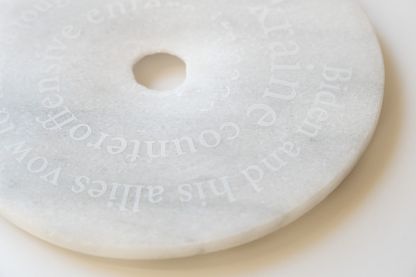
Dr. Klaus Nicolai | SPRING 2022
Katrin Süss, a custodian of the spiraling circular format who understands her artistic formal language more as a dynamic process of moving inward or outward, allows a partial aspect of world political current events to congeal into a kind of stone archive in her documentary art project “Spring 2022”.
For this purpose, she uses a specially developed program, that invariably collects the first headlines of three globally published daily newspapers, namely The New York Times, Frankfurter Allgemeine Zeitung (FAZ) and Komsomolskaya Pravda (KP).
The headlines are artistically applied typographically to circular white marble discs, and can be displayed completely chronologically, in free patterns, or in language groups.
In any case, beyond it’s purely documentary-like “fossilized” aspect, the project is also likely to stimulate furthe rassociations or insights up on attentive observation.
“I would like to see in all explosive places of this world after the end of the year 2022 a huge room installation of three times 363 stone discs, on which – also due to the ‘measure’ of the heatlines – the languages between strategy, diplomacy and ideology wind to1086 spirals. A place of examination, research, documentation –an archive of the world caught up in process.” — Katrin Süss
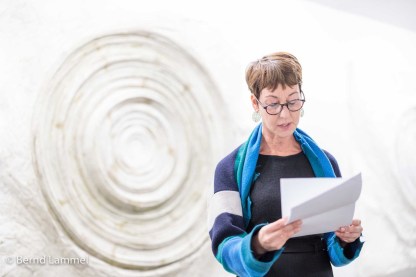
Dr. Susanne Rockweiler | KATRIN SÜSS
On the works of Katrin Süss and and her exhibition „transformed circles“
The work of Katrin Süss is particularly noteworthy in the forms of graphic and object art. In the 1980s she studied painting and graphics at the “Hochschule für Bildende Künste” in Dresden and graphic design in Berlin. Her teachers are formidable artists in themselves. It is worth mentioning four of them by name for their work is particularly worth rediscovering:
Perhaps Süss learned her skills in both line-drawing and of paper-techniques from the wonderful draughtsman Claus Weidensdorfer, who himself was born in 1932 in Coswig, and from Wolfgang Leber, (b. 1932 in Berlin) the amorphous shapes and hesitant colours. Possibly she acquired an apprehension for art filled with suggestive lightness and an unconventional material structure from the painter and teacher Agathe Böttger, (b. 1929). From the artist Eberhard Göschel, (b. 1943 in Bubenreuth near Nürnberg and subsequently lived in the Sächsische Schweiz) also an impressive draughtsman, she gained inspiration to pursue the circular shape.
The circle is one of the most essential shapes of humanity.
The variety of the round is unimaginably wide and reaches across all epochs, encompassing every continent. From the earliest cultures right up to the present, the circle stands for order in the world, universality and openness.
The circle, the round, is the guiding shape of the oeuvre of Katrin Süss, who was born in 1964 in Dresden and is currently residing in Dresden and Berlin.
When we met about a year and a half year ago, she told me about her substantial works made of paper which she developed in 2009 during her scholarship in New York and which can now be seen for the first time in Berlin.
Recent works will complement them:
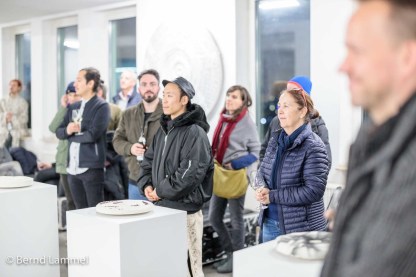
They are round, floor- and wall-works made mainly from corrugated cardboard and fragile Japanese paper or heavy metal. Notably, the works of paper are nearly all square and strangely elevated. They are delicate yet substantial. Many are of a larger scale, particularly those conceived in 2001, which extend to dimensions of up to 230x210cm.
From the square, bulges a curve outward and into itself; circles arch as though they attempt to leave the wall, to grow into the room. One might at first think of her as a modiste in how she comprehends fabric and seems to fashion it into a trim hat, but this wouldn't quite do Katrin Süss justice. There are more procedural steps in play, a masterful craft, which cleanses the solid recycled corrugated paper like a palimpsest by scraping or washing it and inscribing it with delicate white Japanese paper: one of the works is titled "The ancient, erstwhile on new paths". Another is titled "Path" and another "Beginning".
The most impressive circle lies in the atelier's centre: Letters from the "transformed circle"
They guide the possibilities of communication between work, artist and us observers, and steer a path towards the writing, towards thought and the meaning of language to humankind – as well as from one person to another.
The circle is the geometric location of every point located on the so-called Euclidian Plane - were we to draw a line with a compass, fixed to the centre M every point would have the exact same distance to that centre. This is what every point in that circle has in common.
On the topic of the point, one has to mention Sigmar Polke (1941-2010). His artistic work is multilayered, ambiguous, unobtrusive and scrutinising, sage and humorous, critical and derisive.
"You might not believe me when I say that I see the world in dots…" is what Sigmar Polke once said in an interview on the occasion of Galerie H's exhibition "polke/richter richter/polke" in Hannover. "I love all dots. I am married to many of them. I want every dot to be content. The dots are my brothers. I myself am a point.”
The point and the magnification of the point, the circle encompasses you and me without ever excluding us.
Even the picture that we use as our WhatsApp-profile, in order to show ourselves in various circumstances or to allude to our sensitivities, preferences or career choices, is circular and connects us to our loved ones all over the world - quickly and plainly in word and image - and with powerful global collectors of data.
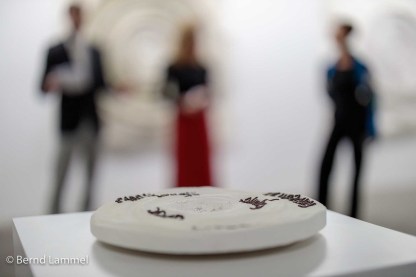
The pie charts we see here are a part of us. We appear in one pie chart or the other, proving or (depending on the origin of the funding) disproving, theses. These pie charts are often used to depict distribution and portions. Recently I read in a newspaper that the number of fractional values may not exceed seven in order to keep the diagram clear and lucid. In reality, we only want to taste the pie, and (here the statistics are correct) not necessarily share it with more than seven people.
You all recognise that we are not dealing with an apolitical or humourless artist. Her art conception lies on the one hand in her dealing with material and on the other hand, in her subtle politics.
And when we turn towards the very large and the very small, frail typo installation with its movable metal letters, that are reminiscent of Johannes Gutenberg and the first printing press, we see that when the letter E is tilted to the left by 90% it can also be seen as a letter W and when we rotate the W by another 180% we are left with an M.
And everyone that can read Cyrillic will know that the Latin W is pronounced as a Cyrillic B, the mirror image of an E becomes a three and in Cyrillic a sonant or an unvoiced S, in Arabic, to name one more example, becomes an "Ain", which in Hebrew is a written S and a pronounced O, and so
on and so forth. You with doubtless also think of more similarities and derivations, and on further levels of the aesthetically formed metal letters and words that shape them.
For in the jumble of letters we quickly arrive at Dadaism of Zürich 103 years ago, in the time of the first world war when artists and literary figures from different nations met up and were left speechless by the war and the pain humankind was inflicting upon itself. With poetic nonsense, the Dadaists would deride the madness of their times in the Cabaret Voltaire where language and images were fractured. The players in Zürich wanted to turn and transform the state to "cucumber salad" and clear the view to the Mediterranean.
Dada is possible, Dada is necessary, Dada lives. Dada was and remains the opposite of Gaga. Gaga is characterised with a multitude of Twitter-Messages from non-politicians - and from politicians which can destabilise nations with 140 characters, to upset witnesses and rule the world as if it were nothing more than a game show.
To Joseph Beuys, art can only be effective in cooperation with language. To him, language was a sort of shaped articulation, in malleable way and therefore more than just an exchange of information. A process of talking, thinking and being silent, to stir the recipient's highest level of mental activity.
For Beuys, the elementary art and language belong together and are therefore a "material talking" about art, humanity and society. But the artist takes a further step. Within her oeuvre she creates references, the domain of which was at first local but which has now become global. Here we see works in reason with a third person: Semblance.
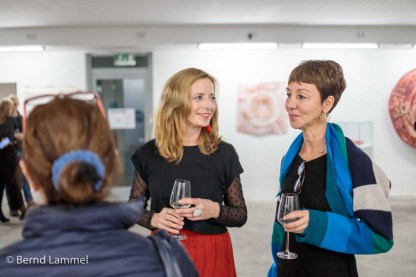
This approach is relatively new in the history of art and culture.
While "discrepancies" caught on in many exhibitions and debates of the 20th century, "semblance" on which our recognition and our judgement is dependant, has of yet failed to attract followers and has seldom sparked discussions.
At the same time, we arrange the world, objects, colours, notes and memories, faces and stories, by discerning and appraising similarities and differences. Localities and distinctions have through continuous globalisation become less local and therefore become more susceptible to scrutiny through the medium of the World Wide Web.
Similarities are overlooked in favour of oppositions as well as differences due to epistemic and political problems. Equality before the law and similarities of cultures complement one another and emphasise that to be "other" is not a given condition but a question of perspective and a new perspective on the palimpsest of history. This brings us back to the work of Katrin Süss: The paper artwork, its shapeshifting letters and the circle bulging into the room as if attempting to escape the realm of the second dimension.
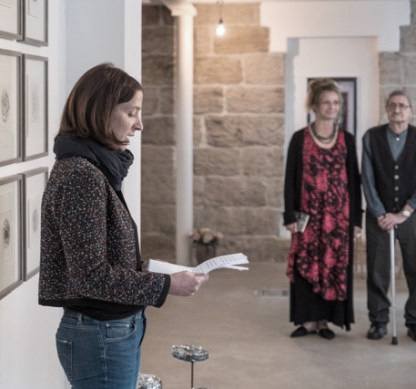
Gwendolin Kremer | ANDERS SEHEN
Dear Ladies and Gentlemen, Katrin Süss and Jürgen Schieferdecker,
I am honoured to greet you all tonight at the opening of this exhibition by the artists Katrin Süss and Jürgen Schieferdecker and briefly to introduce you to their works and their show “seeing differently”. Thank you very much for the invitation.
It is no coincidence that Katrin Süss and Jürgen Schieferdecker`s work can be seen in tandem for the first time in Koenigstein today; their collaboration or mutual involvement has persisted for many years. Following several recurring encounters and dialogues, both Katrin Süss and Jürgen Schieferdecker both recognize shared and similar questions concerning the past, present and future.
One central theme is the recurring reflection with matters concerning Dresden and the virulent questions about society yesterday, today and tomorrow.
Thus we can see Katrin Süss’ transformation of the “Dresden Rose” originating in the twodimensionality of etching, to a three-dimensional version. Beginning with the etchings of the “White Rose of Dresden” which were handed over to the AG 13. Februar in 2011, Katrin Süss
occupies herself with Dresden’s difficult heritage which, with the turning point of its destruction in 1945, struggles with its identity to this day. Is Dresden a city like any other?
The real city today is eclipsed with myths and legends, frequently and increasingly vehemently right-wing populist currents attempt to exploit this identity crisis and to utilize it for their own gain.
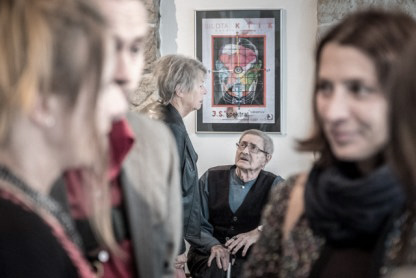
The AG 13. Februar have always made it their mission to counteract this creation of legends and myths – Katrin Süss’ “Dresden Roses” are emblematic of this. The shape of the circle upon which the “Dresden Roses” are based have long been found in Katrin Süss’ works – sketches, etchings, installations and sculptures. The many qualities of the circle fascinate Katrin Süss. In her work, she questions these qualities and lends them a new contextuality with her artistic pictorial language. Often one can find single letters forming phrases which amplify the artistic message.
Jürgen Schieferdecker, too utilizes the artistic practice of the collage, or assemblage, uniting writing, text and photography into one surprising, humorous and invariably cryptic composition. The lynchpin here being – as in the work of Katrin Süss – an examination even the critical commentary to the themes of our time, particularly current happenings in Dresden.
Jürgen Schieferdecker presents an array of self- and double self-portraits: The questioning of the Self, the critical reflection of the Self is prerequisite for interrogation and scrutiny of society. Only those who know themselves are in a position to take a stand, to allocute, not just to present their opinion but to advocate their position. His prints addressing the murder of Jorge Gomondai and Marwa El-Sherbini in Dresden are reminiscent of politically motivated racism and governmental shortcomings.
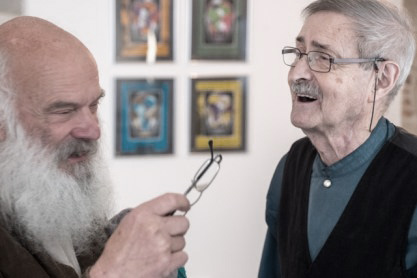
Both artists, Katrin Süss and Jürgen Schieferdecker, have themselves collected empirical evidence from various forms of society and respectively articulated those experiences.
To both artists, Katrin Süss and Jürgen Schieferdecker, this articulation and commentary of this sociopolitical subject is the focal point.
As artists who were influenced by the DDR, Süss and Schieferdecker grapple with the practices of resistance and international paragons. Again and again, we can spot ironically subversive reprimands to authority and prescribed ideologies, in which formalistic standards are skilfully circumvented, exposed and scrutinized with the tools of visual art.
Dear Ladies and gentlemen, tonight I cordially invite you take in the double-show “seeing differently” and to consider the artistic reflection and stimuli, the exchange of ideas of Katrin Süss and Jürgen Schieferdecker, to reflect and to engage in conversation - in the spirit of Hannah Arendt`s “thinking without barriers”
Many thanks for your kind attention.
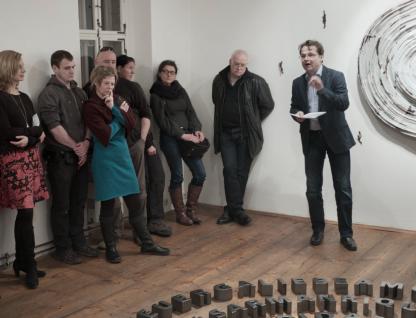
Dr. Paul Kaiser | TRANSFORMED CIRCLES
Whoever may attend this exhibition, whoever navigates this small space with a few steps, has both won and lost, for whoever does so becomes part of the room's programme, and this happens whether he wishes it to or not. It just happens, irrespective of whether he considers the term ''Concept Art'' a phantom of a troubled mind or an acceptable appropriation. Regardless of the position we choose to reveal ourselves in, we must recognise one thing: Even as guests of this gallery-opening, we are part of the material concept, into which Katrin Süss inserts us. Even as a sceptic observer we are active participants, notwithstanding of how we regard this inevitable integration - consciously or unwittingly, affirmatively or defensively, be it with the relaxed stance of an eyebrow-raising of an arts-scene veteran or with the genuine naiveté of one who will still wonder, love and learn, even when he claims his place in this commercialised world.
To be an unsolicited part of an alien concept is to most of us experienced as a daily nightmare, yet here it hits a nerve which, in the light of Katrin Süss's objects and works, might also be considered an artistic encircling in another dimension. One cannot escape this suggestively enacted circle, even if we provokingly question the meaning lurking behind this easily ascertained construction of paper, steel and iron scraps, and if this arrangement is capable of unleashing intensities, which, much like any felicitous artwork, bring our rigid episteme into question.
Seemingly contrary, inappeasable intentions, temporarily connected in a sensory system offered up by the artist – onto this formula, one could project such a desired conceptual consequence. Her project, as the artist and gallerist phrased it in the press release, tries to epitomise an underlying holistic feeling, in the centre of which lies a togetherness of man, nature, and cosmos.
It requires a certain courage to say such a thing and to mean something entirely different. In contemporary society, the term holism has long since become little more than a phantom. One of the reasons being that this guiding concept lacks utopian practice and can at best be applied to commercialism and aberrations that are met with irony, asceticism, and condescendence.
One has to agree: Whether in the promises of molecular gastronomy and physical selfimprovement, whether in the propaganda of the medical insurance companies or through the advertising catchphrases of the psycho-industries which have reached the backstreets of Dresden Neustadt – the cooperation of pervasion and obscurity is inevitable. The term "completeness" has in our environment established itself as a leading wordmark, and the conceptual pair "systemic work" occurs as an indifferent program, suggesting a restoration of this lost "completeness." Consequently, the whole and the healed are confronted with the sick and narcissistic world of which the depressing emblem is the dismissal of utopia, even though this resort to "systemic work" is not just a testimony of a linguistic imposition, but also evidence of historic unlearning. The errings of cybernetics could therfore not have existed.
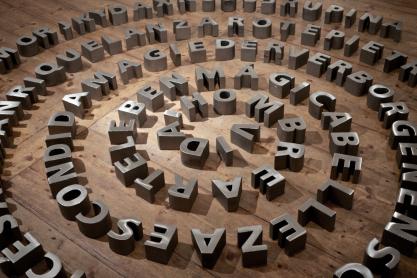
Katrin Süss is most definitely concerned with completeness. To realise this, one does not have to be an expert, either of everyday life or of the assembled milieu of connaissieurs or of art history. A glance at the central symbolism - onto the pictorially artistic thematisation of spiral and circle will suffice.
The spiral, a constant artistic symbol for spiritual strength, here stands for a text message poured into heavy lead. Whoever wishes to explore this space must confront the spiral. He must learn to spell out, to spin a yarn, to liberate his imagination in order to gain word and meaning from the seemingly random sequence of letters. The letters, altogether weighing 450 kilos, bear a sentence conceived by the Spanish artist Cesar Manrique - "the magic of hidden beauty." (More on this artist as inspiration for Süss's works later.) The spiral is in possession of another sensory plane, which circles around back towards the artist. However, considering the broader history of symbols, the spiral stands for a process that every shift, every alteration depends upon - the collapse as anticipation of the unfolding of the self.
The presence of the circle as a second symbol-bearer of the exposition needs no particular elevation. Be it with high or low pressure, on a barrel or in rolled-up paper, be it in the audible medium or in the row of iron circles cast in molten iron at 1600 degrees celsius - the circle is the ordering principle, metaphor and iconic repertoire all at once serving as a central pictorial idea. The symbolically exploited circle often used ad nauseum in advertisements, esoterism and everyday speech, here gains a new definition and is, as the spiral suggests, cleansed of instrumentally symbolic politics. In ancient times the circle already stood for integrity and eternity, often symbolising the sun and the dome of the sky. It can assert shelter, hermeticism and transcendence. The circle stands for a united line against pragmaticism and the infringement of economic power. However, in the true sense of the picture, it is also a barrier against the failing "quadrature of the circle", trying in vain to establish a beginning and an end within the flow of the line. The wide variety of materials that Katrin Süss uses to question the dimensionality of the circle makes clear that the lightness, as well as the heaviness, must confront this task, in order to actualise the idea of the circle, autonomy through transcendence.
Why though this consistent resort to these archaic marks, signals and symbols? Let us ask the artist ourself: With her circles and spirals, says Katrin Süss, she "attempted to physically grasp and then to express the elemental force of the simplistically ingenious universal ordering principals." To her, the spiral forms "harmony" and the circle portrays the "all-encompassing" of all forms of existence.
The referral to self-awareness in the sense of the symbolic meaning of the spiral as a symbol of collapse, described at the outset, does not merely touch upon the mastering of difficult biographical fractures, that have been present in the life of the artist who later studied at the HfbK in Berlin.
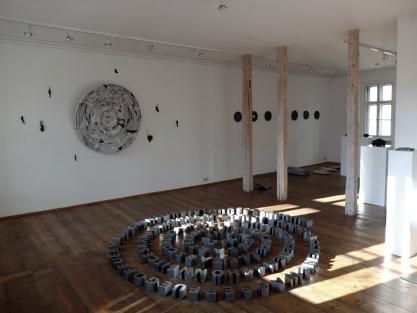
The path towards the circle and concentration on the colour white, in this case, does not necessarily lead down the lengthy path of pure abstraction. This was achieved by the Dresden native Manfred Luther, one of the major artists who devoted themselves to geometric abstraction during the existence of the GDR and later in the presence of Herman Glöckner. Luther was a part of the Dresden non-conformism scene, which Katrin Süss would later approach and from which she would gain lasting inspiration. She doesn´t however, follow these predetermined paths - it is not the enhanced reduction of shapes that tantalise her, but rather the balance between tangible empiricism and analytic distance.
This shape of substantial access requires a theme as well as an ordinance within the here a,d now. Katrin Süss has found both theme and context on the island of Lanzarote, which she first visited in 2009 as part of a scholarship and has since frequently revisited. This exhibition will also be open to the public in April. Lanzarote, one of the Canary Islands, has an austere appeal, flatly dubbed by some visitors as a "heap of ash and wreckage", is characterised by its volcanic landscape with rough edges, harsh debris and bumpy trails. In any case, Lanzarote represents the counterpart of a hedonistic holiday destination of the postmodern world. Nevertheless (or perhaps for this reason) the island is threatened by the oil industry, for the Spanish oil company, Repsol has discovered a vast oil deposit on the bottom of the sea about 250 kilometres
from the shore. It promises up to a billion barrels of oil and therefore naturally has long since triggered the dynamics of capitalism. For Katrin Süss this threat to an incomparable natural habitat represents the matrix, with which she exemplarily tests this moving programme.
It is the Spanish painter, sculptor and architect Cesar Manrique, who became the trust in spirit - a warrantor of a change made possible by art. He stands for the success of varied declined circles, which Katrin Süss has also made her own, for a life-principle of unwavering hope of harmony
through action and unfolding of consequence. This principle requires both circulation and the drawing of circles.
Manrique, who was born in 1919 and died in a traffic accident in 1992, became the admonisher, champion and saviour of an island that was in danger of being caught in a net of mass tourism and economic interests. Following his return from New York in 1968 the artist played a substantial part in the development of the island, which is now a protected nature reserve, espoused by Pepin Ramirez, an old friend of the family, who had been appointed President of the island. Manrique left his artistic traces everywhere - his art always serving the interplay between humanity and nature.
If Katrin Süss distributes a small edition of his manifesto to the visitors of today‘s exhibition, it musn‘t be seen as an act of pathos in the context of conceptual artistry. It is the courage of facing changes. Courage in the sense of artistic utopia that transfers the the principle of holism into tramsformed circles and with the aid of perpetual circulation into new meanings of sense.
Thank you!
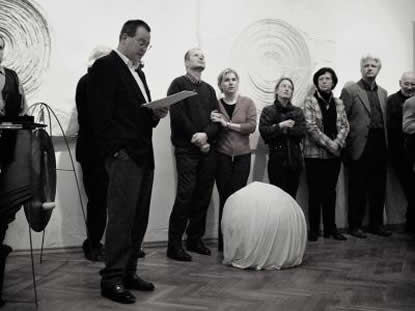
Dr. Ullrich Hartung | KATRIN SÜSS – CIRCLES
There is an old saying among art historians: „You only know what you see„, often juxtaposed by its antithesis: „You only see what you know” Apart from the question whether women see different things or certain things differently than men – the first thesis demands that one gets involved with an artwork’s shape, its structure, its composition, its entire appearance, only by doing so can it be understood, can the artist’s intentions be truly comprehended.
The necessity for this is obvious, for if an object’s appearance is seen merely as a concealment of its true entity, the denial of the inner correlation between the two results in the refusal of understanding the work. This tells us more about the viewer than about the artwork itself: it is an attitude towards the work, indeed an irrational one that stems from being afraid of thinking.
On the other hand, a knowledge that has been acquired through having seen other works, an awareness of styles, beliefs, and the physical image of an era can very well further the perception of artwork. Insofar, the second thesis proves a point as well: the analysis of what is right in front of our eyes and the research of the reasons and conditions concerning its genesis can enlighten each other.
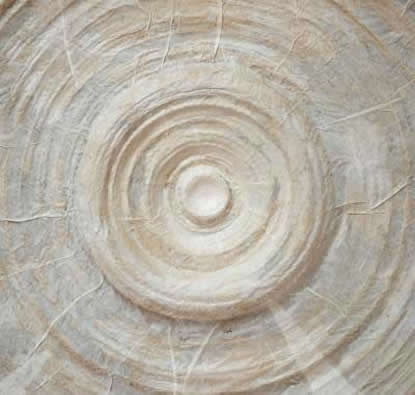
When we look at Katrin Süss’ works in this exhibition, what do we see and what do we need to know? We see circles, rings that gyrate around a centre, pasted over with white silk. Like skin, the tissue stretches over the circles’ grooves and ridges, occasionally the underlying material, simple grey corrugated cardboard, breaks through.
We quickly realise what we instinctively felt from the start – we are not looking at a positive shape on the fine paper surface, but a three-dimensional body that hovers above the area, held up by gauze. At first sight, the discs with their strong relief seem to be the active part of the composition – do they not imprint themselves onto the paper, do they not draw the surface towards them?
But the outer shape, a square, lends a moment of tranquillity to the circular movement. This other elementary shape corresponds with the roundness, embedding it in space, in width and height. Equally, the whiteness of the silky paper merges the circle with the square. This characterises the front face, whilst at the back, and only there, the grey cardboard just sits on the surface. This is obscured to the view, instead a secret dominance of the surface is maintained, for the centre of the circle is always empty.
Here the white reappears, pure and strong, surrounded by a severe vortex, as if pushed out by them or in great depth. Thus, tranquillity and movement have been brought into a state of balance because they are allowed to exert their opposing forces.
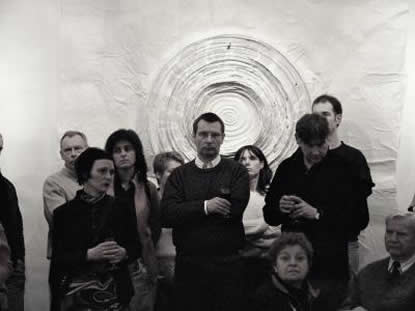
Perhaps one of you has once attempted to square the circle. You probably failed due to your lack of knowledge of higher mathematics. But you certainly distilled enlightenment from the experiment: Square and circle are symmetrical shapes, closed up in themselves, formed from a central point into all directions in a regular way. The circle is the most secluded shape. The curvature of its silhouette is constant in such a way that it is impossible to say „into all directions„ as it creates a closed space that is as void of direction as the outer space, making the latter look utterly open and undefined. The circle refuses any kind of relation to other shapes thus representing the absolute elementary shape.
This element of detachment has turned the circle into a symbol of absolute power, a spellbinding force is attributed to the curved line. This did not happen as a cause of a mere assignation, not purely arbitrarily as the aesthetes of reception may assume, but by a conscious application of the abstract, deducted shape that lent itself, above all others, to the depiction of a likewise abstract purport. No randomly chosen convention but the expression of the form itself qualified the circle to epitomize a magic power.
This element of detachment has turned the circle into a symbol of absolute power, a spellbinding force is attributed to the curved line. This did not happen as a cause of a mere assignation, not purely arbitrarily as the aesthetes of reception may assume, but by a conscious application of the abstract, deducted shape that lent itself, above all others, to the depiction of a likewise abstract purport. No randomly chosen convention but the expression of the form itself qualified the circle to epitomize a magic power.
The character of its shape bestows an impression of tranquil magnificence upon the gigantic ecclesiastical rotundas of mediaeval and modern times. Their inner spaces were designed to unite believers into a closed community.
But the strict circular shape could only be applied upon their layout. The circle, strictly speaking, is atectonic, as any bracing, any annexation to other shapes disturbs its oneness.
As a room, as a globe, it would be unusable. As an element it has the appearance of a symbolic, law-abiding shape, merged into the building structure through auxiliary constructions.
When Wilhelm Kreis („Kreis” meaning circle) furnished the Dresden Hygiene Museum with large rose windows thus metamorphosing his name into stone, he made use of a coincidental analogy, suggesting that religious cult has been replaced by personality cult in the 20th century.
The square, however, can be stored, stacked and piled up without ever losing its formal quality, which is why it became the most distinctive symbol of architectural elementarism.
Ecclesiastical architecture of the Middle Ages used the equilateral rectangle as a three-dimensional module while the square was re-discovered around 1800 and 1900 as an element of order. The catholic architect Rudolf Schwarz used it for his church buildings and Munich designer Wolfgang von Wersin employed it as a trademark for his exhibition „Ewige Formen„ (Eternal Shapes). Oswald Martin Unger, from the same school of thought, has been creating such buildings to this day.
Circle and square are and have always been symbolic shapes representing order, embodying the purity, the beauty of an immanent law, witnessing the unity of nature and works of Man. An inner congruence of thought and form has bestowed this upon them.
All this and much more we may know, but is such awareness sufficient to understand the works that surround us in this exhibition?
Initially: White, the colour of these surfaces, the colour of abstraction, is simultaneously the sum of all colours and the initial point for all possible play with colours. It appears to be empty but may be the end, the start or the momentary state of a movement. We notice the different size of these discs-they display the same in various alterations, when one picture may have been sufficient to embody the symbol in its entire purity.
But the discs as manifold variations on the strict subject convey a sensual power: The rings stand out, form terraces and create round landscapes of three-dimensional and spatial energy.
They give out the impression of standing before the traces of a human hand that shaped clay on a potter’s wheel.
This calm movement reveals the idea of an order that facilitates indefinite freedom. The cosmos and the works of Man are not one, but these circles represent more than a dream: the strong conviction that the laws of the world and the order of the human spirit may correspond. We experience them as symbols of a living order, not an abstraction of life but its abstract expression.
Katrin Süss did not create these circles as formal exercises or objects of demonstration for her design students. Nor did she aspire to express her subjectivity, her inner order through free constructions. There was a time when she felt a need to reclaim this order for herself, and she found it through these figures made of cardboard and white paper.
Her visions of „round pictures” began when her first child died, when she was forced to hold out, aided by others but powerless in the face of a long-lasting process of dying, hardly able to find any strength within herself. During these days and weeks, being near her daughter, having silent dialogues with her, gave her back her creative energy. Images of tremendous beauty and completeness sprung to her mind, strengthening her. There could be no consolation from outside herself, all the words and phrases she received were incorporated into the concentric vortices of her visions. She needed to place these images outside herself, turn them into something tangible. She did that. For her, it was the solution in the double sense of the word.
Has Katrin Süss squared the circle? She will carry on creating circles, larger ones, different ones. The quest for new landscapes always origins in listening to one’s inner urges, in sketching out a psychogram, later, when the work is under way, Reason takes over the work. This is not an exhibition or remembrance but an invitation to think.
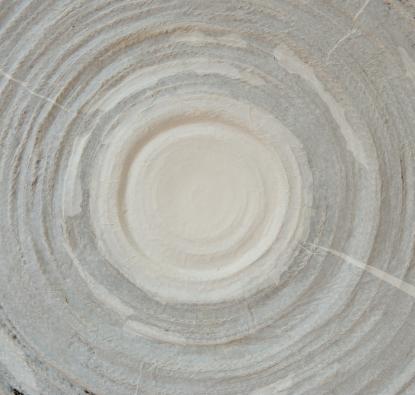
Susann & Ulf Krüger | SQUARING THE CIRCLE
The circle is a highly symbolic icon representing absolute, quintessential and divine things such as infinity, eternity and reincarnation. Beginning and end are one. The helix has been attributed similar qualities such as cyclic expansion, regeneration and „evolution” in the mystic, cosmic sense of the word. In sepulchral art, it even epitomises the cycle of a human life.
Katrin Süss’ work benefits from her studies of painting and graphics at the Dresden Academy of Art and graphic design in Berlin. Breaking up the conservative rectangular form is the basis of her art. Further principles of her creative work are the renunciation of colour favouring white and the negation of corporeality for the benefit of icons and symbols.
When her first-born daughter Clara died in the 1990s, the imagery of the circle turned into a highly personal part of her creative work. Süss began reeling up oversized wheels. Resembling landscapes and earth structures, the rough and smooth surfaces appear to lead into infinity, like the lifeline of a never-ending story. The heavy objects, sometimes over a meter in diameter, were placed behind white, silky Japanese paper where they assumed an almost hovering lightness.
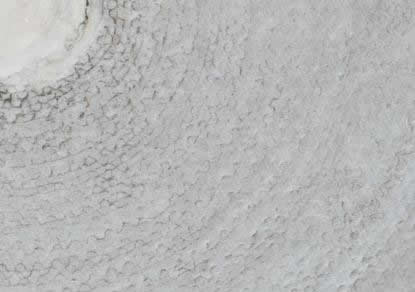
Katrin Süss has never since been able to break away from circular shapes, it still dominates her graphic oeuvre, occasionally interspersed with works in corrugated cardboard. Her bread-and-butter-job as lecturer on typography at the AIK Academy sparked off a new fascination with the transformation of icons as well as media of storage and communication throughout the centuries. The underlying idea is the safeguarding and reproductibility of thought and knowledge. All the elements involved- icons, technique, printing block and image, as artistically unconventional as they may seem- are merely vehicles to convey, preserve and reproduce an image.
When Johannes Gutenberg invented mechanical letterpress printing with movable types in 1450, he revolutionised the use of writing that had been elitist for 6500 years. The production of books was the exclusive right of the monasteries where monks constantly copied current works. Gutenberg’s invention made it possible to mechanically reproduce a plethora of thought and knowledge, causing a radical multidisciplinary change of society’s structure, altering all Western European civilizations within a short space of time.
This development is comparable to the ground-breaking inventions for the transmission of writing and ideas in the last decades of the 20th century. Especially the visionaries of the „Silicon-Valley-Community” created an individually applicable mini computer and again revolutionised the human history of writing. Writing stepped out from traditional carriers and began to explore virtual space.
As a graphic designer, Katrin Süss is permanently surrounded by the world of computers, yet she highly appreciates the traditional techniques of „black art”, as the historic synonym for letterpress and copper printing calls it. In her works, she aspires to combine traditional methods with contemporary materials. Until the mid-1800s, printing was used merely as means of reproduction.
The quality of the finished print depended upon the printer’s ability to transform the effects of a medium (ie a painting) into another. Thus printing was an interpretation. The resulting image did not represent the work of the original but that of the reproducing artist. Prints were produced in unlimited numbers and their manufacturers endeavoured to preserve the printing plates, sometimes by steeling, in order to print large editions.
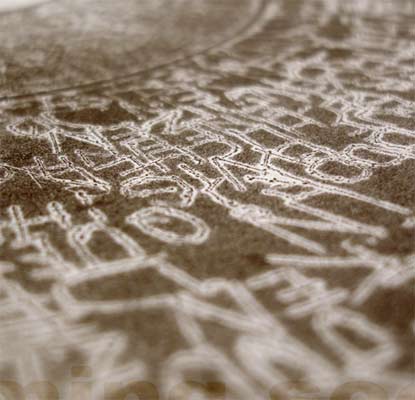
Katrin Süss adhered to the classical technique of dry-point etching when she created her circles, but made the pointed tool meet up with 20th century storage media. CDs, DVDs and LPs served as printing plates and had HTML commands, poetry and prose etched upon them. New York friends of her art thought it a sacrilege when they learned that she processed works by the Beatles as they considered these records to be sacred. But it has turned those prints into highly special and unique works. By now, they call one of these rare copies their own.
While CDs are a suitable print medium, LPs only provide one or two usable prints. The printer Jochen Lorenz from Obergrabenpresse had the special touch that was necessary to wrest usable results from these unconventional printing plates. Their whole appearance makes them clearly identifiable as records – even a few grooves remain visible – and remind the viewer of golden records, awarded in the music business. The etched texts, symbols, concert reviews and journalistic essays about music – appear as a mixture between relief and gravure print while the background oscillates in various shades of grainy grey and white.
The etchings made on CDs expose their image more readily: black icons on a white background, perfectly legible. The graphics that were created on the island of Lanzarote are more enigmatic. The dark discs, partially brittle looking, resemble the lava rocks that dominate the Canary island and are a tribute to César Manrique, who used to work there. Other than most tourists, the artist, architect and environmentalist, who died in 1992, perceived his homeland as a wild, vibrant and beautiful landscape, to which he added several attractions. The most characteristic feature of his work is the integration of rocks, stones and solidified streams of lava into a harmonious living space. The colours black, grey and white are frequently used. Süss was especially impressed by Manrique’s residential home, erected in five lava bubbles, that houses the Fundación César Manrique foundation. The subterranean caverns open up to the sky and even have trees growing out of them. This is echoed by Süss’ Lanzarote CDs that likewise lead from darkness into the light in their centres.
The point is not the perfunctory content of the silver discs but their shape, which is thousand of years old. Superficially, they form a circle as the carrier of a permanent image. Their ability to reveal or store an enormous amount of information appears to be secondary. The ancient form as a constant seems to brace itself against the volatility of invisible icons.
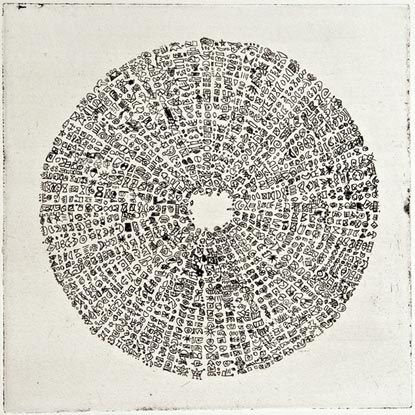
Katja Altmann | ETCHINGS
Extracts from the opening speech to the exhibition „Man, Water, Life”, Alte Wasserkunst Bautzen, by museologist and cultural manager Katja Altmann.
With the etchings on show here, Katrin Süss gives us an insight into another field of her artistic work.
The art of etching was developed in the 16th century. It was used by artists such as Dürer, Rembrandt and Goya, but also by Picasso, Chagall, Horst Jansen and Miró. An etching is a gravure printing process requiring the artists to „dig” dots and lines into the smooth surface of the printing plate by engraving or etching with acid. Printing paint is rubbed over the plate, only remaining visible in its grooves after it has been wiped off. When moistened paper is placed onto the plate, it draws the paint from the indentations. The plates of the works on show here were created in 1998 and revised in 2006. First etchings depicting faces were continually reduced in the work process. Now they show reduced, clear shapes, often circles.
Katrin Süss was invited to have her prints done by Obergrabenpresse Dresden, as a result of her exhibition „Circles”. A great honour as Obergrabenpresse is in a position of being able to chose who they print for. Peter Herrmann, Ralf Winkler (Penck) and Professor Klaus Weidensdorfer all have their printing done here. This is a compliment on the etchings’ quality. The artistic content, outstanding printing technique and the use of hand-made paper complement each other and the result is outstanding!
Newsletter